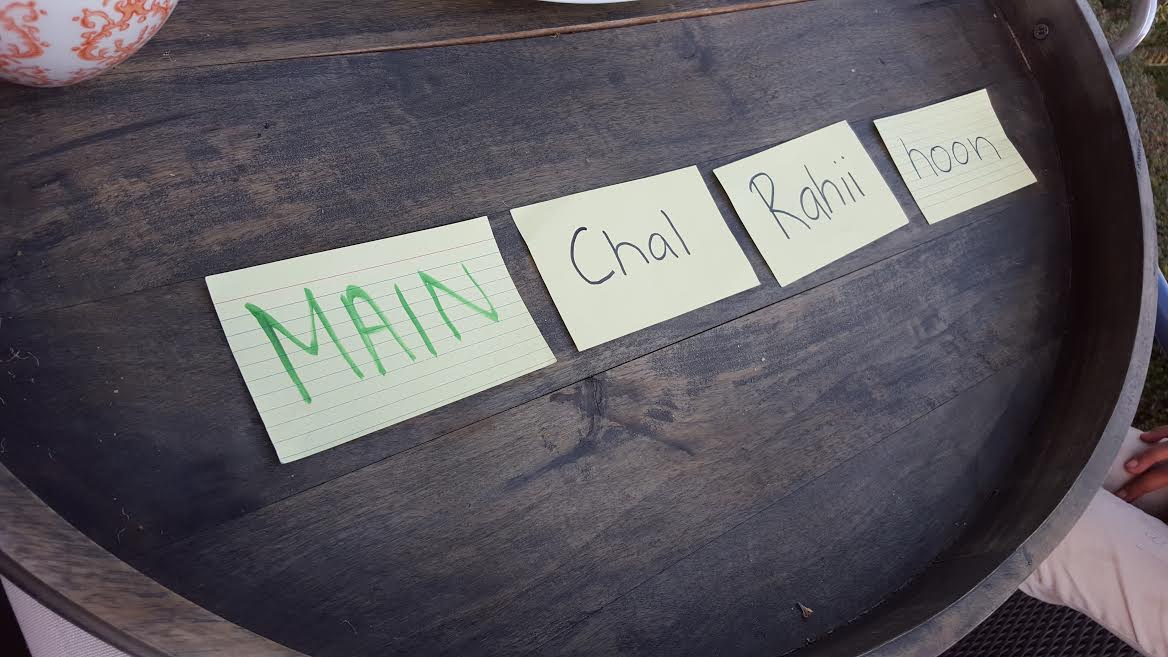Seeing the word Devanagari in the title, most of you must have got an idea that this is going to be a Hindi related post. Yes, you guessed that right.
Teaching our kids Hindi is a challenging task for the parents living abroad. Till the kid is at home, we are able to maintain the routine of practicing Hindi (both written and verbal) at home. But once they start school, it becomes hard to keep up with the Hindi practice along with their regular studies. If your mother-tongue is other than Hindi (like my mother-tongue is Marathi) but your India trip covers the states where Hindi is the primary language then there is a choice to be made which language should be given the preference. In most of the cases we start with practicing the mother-tongue and slowly introduce Hindi to our kids. Obviously, we follow the same method of teaching as it was been taught to us which means starting with the Denanagari script.
In today’s guest post, Reena Bhansali presents her thoughts about why the script need to be taught last. Let’s read…
Six Unexpected Reasons Why Devanagari Needs to be Taught Last:
Regardez les branches
Comme elles sont blanches,
Il neige des fleurs.
Riant de la pluie
Le soleil essuie
les saules en pleurs.
Unless you speak French, the above poem extract means nothing to you. You could probably sound out the letters and read it out loud – but in reality, it is just jibberish.
This is what it is like if your kids do not understand or speak Hindi, but are taught the alphabet first. They can read the alphabet. Use the matras. But it means nothing if they cannot answer “aapka naam kya hai.”
As an Indian who grew up in the US, my siblings and I started learning Hindi through conversation. We would talk to my grandmother in Hindi, watch movies, and learn new words by asking questions and actively using them. I only learnt the alphabet when I was older, when I understood a good chunk of what I was reading and writing.
So many apps and Hindi materials out there start by showing your child the alphabet. They want them to remember the letters, trace them and learn 3-4 words that start with that letter. Does this help your child learn Hindi now? Does it get them closer to speaking with their family in Hindi? NO!
When I started teaching – with other Hindi teaching schools – they believed the alphabet was king. I would say “Ka” and the class would drolly repeat after me and I would provide some associated words like “kabutar” and “kachua.”
Within a few months, about 60% of those students either 1) lost interest in learning the language or 2) continued to learn, but hated it. Essentially, they had given up — and they hadn’t even learnt anything of value yet.
If you want to teach your kid Hindi – your success rate will be guaranteed to go up if you teach Devanagari LAST. Why?
- It’s the least important aspect of learning the language – While learning Hindi script is important, it is actually just a tool to express a language you already know. That’s why your child needs to actually learn that language first, then focus on reading and writing.
- Wastes Time – If you are like the rest of us, you don’t have much time in your day that isn’t filled with driving your kids around, doing homework, and eating. If you are going to commit yourself to teaching and encouraging your child in Hindi – go straight for the meat and get them to start USING the language ASAP. Learning “ka” “kha” wastes precious energy and diverts time away from actually learning Hindi phrases, songs, words, stories. You don’t know how long it will keep their interest, so you might as well get the real Hindi (conversation, words, sentence structure, answers, etc.) out of the way first.
- Makes kids lose interest – Tracing a letter over and over is probably the least engaging activity a child can do. There is no two ways around it. It is especially boring if they have no idea how the letter is used every day. Once your child finds soccer, dance or any other more engaging activity, Hindi will happily fall to the bottom or even fall off their list of to-dos completely.
- Few real world rewards or satisfaction – Living outside India, kids rarely see Hindi script written on signs or on posters. And without being able to see Hindi script in real life, they won’t be able to see their efforts pay off. Unlike kids in India, kids living overseas can’t look at the writing on a truck and say “hey! I know that word – it says “Laloo ki gaddi!” Without this luxury, the barrier between them and Devanagari just grows.
- Offers few skills to show off their efforts – How will your child show off Devanagari at the next Desi family wedding? Unless you carry around a chalkboard it’s not going to happen and your child will miss out on some very valuable positive reinforcement that would otherwise fuel them to keep learning. Flip that and imagine they spent all that script-memorizing-time on learning words and phrases and conversation. Oh the possibilities and the fun that would ensue.
- Letters don’t give them a back and forth to continue learning – Once you learn the alphabet, that’s it, you’re done. You could learn a few vocab words like “khargosh” or “kitaab” but it would stop there.
On the other hand, a child can learn a phrase — mosey on out and use it with a relative or at a local Indian restaurant and get two totally different answers. With each response your child will learn even more Hindi. The magical flow of conversation naturally keeps teaching them more and more (that too, without you having to lift a finger).
WHAT IS A PARENT TO DO?
Forget the tools, also known as the alphabet (for now) – go straight to the core!
We need kids to believe that Hindi is a real language that can be used in everyday situations. It can’t just be hard letters. It needs to come alive on TV, on the radio, through music, through dance and most important of all through CONVERSATION.
If you want your amazing bright and colorful child to actually get intertwined with their culture and feel close to family and conversation needs to be the star.
Don’t get me wrong, Devanagari is important to learn…LAST. Let your kids know what they are saying before they know how to read and write it. Don’t waste your energy perfecting a written language that your child will rarely see except during trips to India.
WHAT SHOULD REPLACE DEVANAGARI
- Teach your child how to introduce themselves.
- Teach them 5 nouns that you think are important – maybe kitaab, gaadi, joota,
- Introduce them to Hindi action words (like “nacho” or “gaao”) by acting them out. Ask them to do the same and they’ll remember it better and have fun while doing it.
- Watch Hindi movies or TV shows and explain some key words.
- Find language worksheets and materials that work for you.
Reena Bhansali has been teaching Hindi for 5+ years and is the founder of Hindi By Reena, the only comprehensive online platform that teaches your child top to bottom Hindi — using material that focuses on immersion and CONVERSATIONS they will actually encounter in real life.



